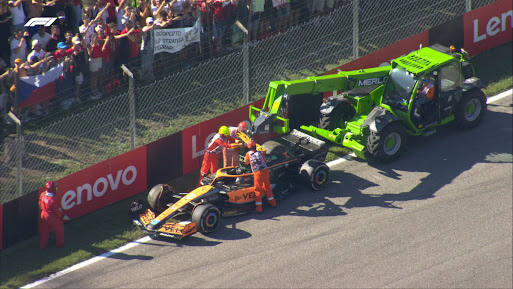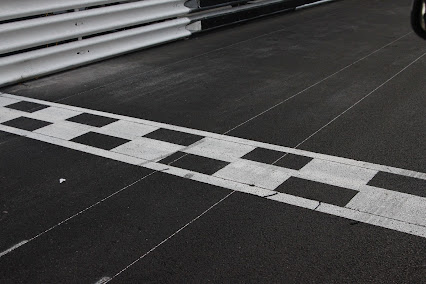The Ricciardo case in the F1 Monza Gp: does something need to change?
Abstract
After a brief analysis of what happened with the retirement of Daniel
Ricciardo in the Formula 1 Monza Gp, this article will focus on the rules and
the procedures related to the safety car deployment, trying to un
What
Happened?
The 2022 Formula One Italian GP was one of the highly
anticipated GP of the season on one of the most iconic circuit of motorsport.
In the last stages of the race, during lap 47, the n.#3 car driven by Daniel Ricciardo ended his race, due
to a failure, and the Aussie driver parked his car in the grass area just
before the second Lesmo corner. The spot and the position of the car made
necessary the use of marshals and
vehicles on the racetrack to remove his McLaren. Although the situation was
clear, the race direction waited a long amount of time before deploying the
safety car and start the procedure. In addition to this, the pace car failed to exit in front of the leader and this caused
the race ending behind the safety car, a decision that produced a lot of
controversy and disapproval from fans.
Was the
safety car procedure correct?
After what happened
in the last year Abu Dhabi Gp, the safety car procedures are becoming a lot
more under the focus of the fans and also the rules were modified to avoid such
debateable circumstances. In the
Monza case, the excessive prudence used in the phase of deciding whether or not
deploying the safety car was mixed with a completely luck of concern about
safety in the practical procedure.
It is important to
say that the procedure itself suffers of three big mistakes:
1.
the huge amount of time used to take the decision;
2.
the effective deployment of the safety car on the
track
3.
the practical operation carried out to remove
Ricciardo’s car.
Speaking about the
first error, is important to remember how Formula one is such a fast-paced
sport and this is absolutely not compatible with decisions taken with so much
delay. This is even more important in case of accidents that can cause safety
issue to other drivers, like in Ricciardo’s case, considering where he left his
car on track.
Regarding the second
error, is important to note
that it is only an evaluation mistake, because the 2022 F1 Sporting Regulation
under the article 4.12.6 states that: “The
safety car will join the track with its orange lights illuminated and will do
so regardless of where the race leader is”.[1]
But even if is not stated, as it was before, is still better to coordinate
the exit of the Safety with the arrival of the leader on the straight to make
the procedure as fast as possible.
Concerning the last,
and the most dangerous error, the use of tractors and marshals on circuit is
always a situation that needs to be avoided, mostly if, like in this case, the
heavy vehicles went in the opposite direction of the Formula 1 cars. The safety
issues were highlighted by the really close passage between Nick De Vries and
the tractor during one of the laps under the safety car. After the tragical
loss of Jules Bianchi, avoiding every dangerous situation like this one is a
categorical choice, with the unavoidable purpose of preventing certain tragedies
from happening, without changing rules when it’s too late.
Excluding those
mistakes, the procedure was following the rules and the F1’s regulations. It is
important to underline this, because the end of the race behind the safety was
necessary, even if it was caused by the errors afore mentioned.
Is it necessary
to change something?
After the analysis of
what happened, it is important to ask ourselves if it is necessary to change
something to prevent similar situations or even worse ones happening. The
natural answer is yes, obviously. But it is also important to try to find
some useful solutions for improving the current condition.
The first procedure that could be implemented, which doesn’t even need a regulation change, is the use
of the red flag in all the
situations in which moving
vehicles are necessary to
remove F1 cars on track. This choice, even if a bit extreme in an abstract
context, is also supported by the current regulation that indeed states, in the
article 4.14 of the F1 Sporting regulation, that: “If competitors or officials are placed in immediate physical danger by
cars running on the track, and the clerk of the course deems circumstances are
such that the track cannot be negotiated safely, even behind the safety car,
the race will be suspended”.[2] It
is clear that, in the
case afore mentioned, there was a clear risk for drivers and
marshals for several reasons. The use of the red flag would also help to avoid
finishing a race behind a Safety car, which is disappointing for fans
and unhealthy for the sport itself.
Another important
thing will be creating a clear procedure that race direction needs to
follow about timing of decision, to improve efficiency in such situations. This measure needs to be combined with
less discretion given to the race direction about what kind of measures can be applied to different
scenarios. Discretion represents
a necessary relief valve in a system so complex as F1, but it must not become an obstacle to safety or even
just to the regularity of the competition.
In the end, it is
clear that the rules need to be improved to remain on point in a sport that
create such heterogeneous and complex situation. Monza is only one of the
plethora of examples that are just stressing how much a change is needed. This
is a year of great revolution in Formula 1, due to the technical and sporting
regulation changes, so it will be a great missed opportunity if this time
frame, prone to structural modification on rules, will not be used to make F1
safer, more certain and
enjoyable.




Commenti
Posta un commento